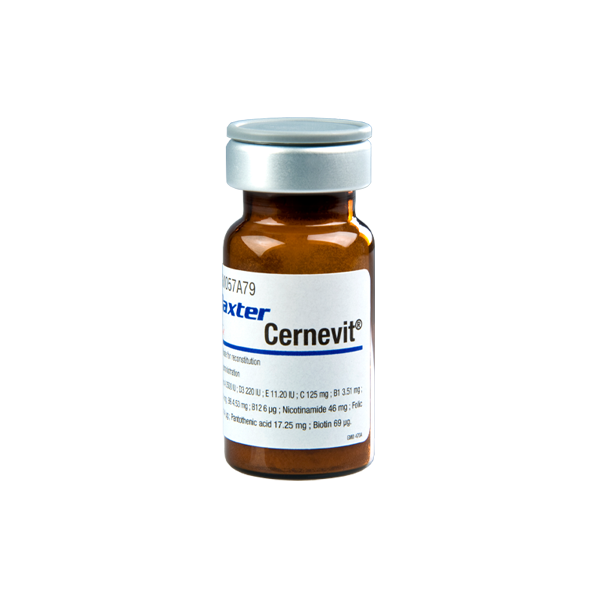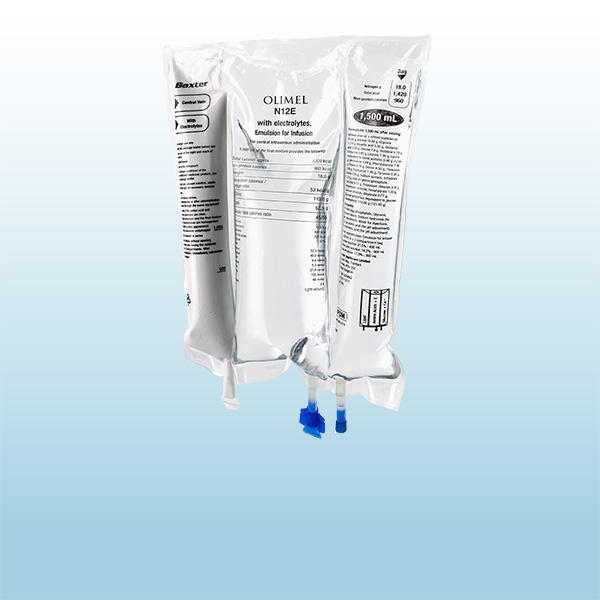Cernevit
A 12-in-1 multivitamin that delivers both water- and lipid-soluble vitamins essential in parenteral nutrition.

When you give them macros, don’t forget the micros. Micronutrients are a key component of parenteral nutrition (PN) and essential for optimal human growth and development.1,2 Cernevit is a 12-in-1 solution of essential vitamins for patients greater than 11 years of age and is aligned with international guidelines.1,3 Cernevit is comprised of water-soluble vitamins B1, B2, B5, B6, B12, C, biotin, niacin, and folic acid, as well as lipid-soluble vitamins A, D3, and E.3

Vitamin deficiency can lead to organ dysfunction and poor wound healing
Micronutrients, including vitamins and trace elements, are essential components of a balanced nutritional intake and therefore critical parts of PN.2 Lack of vitamins can have severe health consequences for patients and may lead to organ dysfunction, muscle weakness, poor wound healing, and altered immune status.2 Vitamin deficiencies may occur within weeks or can develop over a year or more after being on a deficient diet.4 This makes the adequate and accurate provision of vitamins essential to achieving optimal patient outcomes.
A multivitamin that covers your patients’ nutritional needs

12-in-1 lyophilized formulation
Mixed micelle technology allows water and lipid soluble vitamins to be combined in a convenient single-dose vial.5

Flexible, easy to reconstitute
Minimizes medication error risk and can be added to PN solutions with or without lipids, provided that compatibility and stability have been confirmed.3,6,7

No refrigeration required
Can be stored at room temperature for up to two years when unopened for enhanced convenience and access at point of care.3

Formulated without vitamin K
Can be administered to patients taking vitamin K antagonists, such as warfarin, without impacting anticoagulant control.3,4

Cernevit
Download the Baxter Parenteral Nutrition Compatibility Guide for compounding and multi-chamber bag compatibility and stability information.
Learn more about Cernevit attributes and components in the Cernevit Fact Sheet.
Learn more about Clinical Nutrition

Important safety information
CERNEVIT, powder for solution for injection or infusion, orange yellow sterile cake of powder.
QUALITATIVE AND QUANTITATIVE COMPOSITION
One vial (5 ml) contains : Retinol (Vitamin A) in the form of retinol palmitate 3500 IU; Cholecalciferol (Vitamin D3) 220.000 IU; Alpha-tocopherol (Vitamin E) 11.200 IU; corresponding to DL alpha-tocopherol quantity 10.200 mg; Ascorbic acid (Vitamin C) 125.000 mg; Thiamine (Vitamin B1) 3.510 mg; in the form of cocarboxylase tetrahydrate 5.800 mg; Riboflavin (Vitamin B2) 4.140 mg; in the form of riboflavin sodium phosphate dehydrate 5.670 mg; Pyridoxine (Vitamin B6) 4.530 mg; in the form of pyridoxine hydrochloride 5.500 mg; Cyanocobalamin (Vitamin B12) 0.006 mg; Folic acid (Vitamin B9) 0.414 mg; Pantothenic acid (Vitamin B5) 17.250 mg; in the form of dexpanthenol 16.150 mg; Biotin (Vitamin B8) 0.069 mg; Nicotinamide (Vitamin PP) 46.000 mg Other ingredients: Glycine 250.000mg, Glycocholic acid 140.000mg, soybean phosphatides 112.500mg, sodium hydroxide, hydrochloric acid qs pH5.9
Uses: CERNEVIT is indicated for adults and children over 11 years of age. When the daily requirements of vitamins are required to be given to the patient by the parenteral route because oral administration is either contraindicated, impossible or insufficient (eg due to malnutrition, gastrointestinal malabsorption, etc).
Dosage: Adults and children aged over 11 years: 1 vial/day.
Administration: Method of reconstitution: see section Instruction for use and handling. Intravenous route: By slow intravenous injection (at least 10 minutes) or by infusion in a solution of 5% glucose or 0.9% sodium chloride solution for infusion. Cernevit may be included in the composition of nutritive mixtures combining carbohydrates, lipids, amino acids and electrolytes provided that compatibility and stability have been confirmed for each nutritive mixture, to meet nutrient needs and prevent deficiencies and complications from developing. The total vitamin amounts from all sources such as nutritional sources, other vitamin supplements, or medications that contain vitamins as inactive ingredients (see Interaction with Other Medicaments and Other Forms of Interaction) should be considered. The patient’s clinical status and vitamin levels should be monitored to ensure maintenance of adequate levels. It should be taken into account that some vitamins, especially A, B2, and B6 are sensitive to ultraviolet light (e.g., direct or indirect sun light). In addition, loss of vitamins A, B1, C, and E may increase with higher levels of oxygen in the solution.
These factors should be considered if adequate vitamin levels are not achieved.
Contraindications: hypersensitivity to the active substances, especially vitamin B1 or to any of the excipients, including soy protein/products (lecithin in mixed micelle is soy-derived) or peanut protein/products, hypervitaminosis from any vitamin contained in this formulation, neonates, infants and children less than 11 years old.
Special warnings and special precautions for use:
Warnings: Hypersensitivity Reactions: Severe systemic hypersensitivity reactions have been reported with Cernevit, other multivitamin preparations, and individual vitamins (including B1, B2, B12 and folic acid). Reactions with fatal outcome have been reported with Cernevit and other parenteral vitamin products (See Undesirable Effects). Cross-allergic reactions between soybean and peanut proteins have been observed. In some cases, the manifestations of a hypersensitivity reaction during intravenous administration of multivitamins may be rate related. If infused intravenously, Cernevit should be administered slowly. If injected intravenously, the injection must be administered slowly (over at least 10 minutes). The infusion or injection must be stopped immediately if signs or symptoms of a hypersensitivity reaction develop. Mild allergic reactions such as sneezing or mild asthma are warning signs that a further injection may give rise to anaphylactic shock. Vitamin Toxicity: The patient’s clinical status and blood vitamin concentrations should be monitored to avoid overdose and toxic effects, especially with vitamins A, Dand E, and in particular in patients who receive additional vitamins from other sources or use other agents that increase the risk of vitamin toxicity. Monitoring is particularly important in patients receiving long-term supplementation. Hypervitaminosis A: The risk for hypervitaminosis A and vitamin A toxicity (e.g., skin and bone abnormalities, diplopia, cirrhosis) is increased in, for example: patients with protein malnutrition, patients with renal impairment (even in the absence of vitamin A supplementation), patients with hepatic impairment, patients with small body size (e.g., paediatric patients), and patients on chronic therapy. Acute hepatic disease in patients with saturated hepatic vitamin A stores can lead to the manifestation of vitamin A toxicity. Refeeding Syndrome in Patients Receiving Parenteral Nutrition: Refeeding severely undernourished patients may result in refeeding syndrome that is characterized by the shift of potassium, phosphorus, and magnesium intracellularly as the patient becomes anabolic. Thiamine deficiency and fluid retention may also develop. Careful monitoring and slowly increasing nutrient intakes while avoiding overfeeding can prevent these complications. Should nutrient deficiencies occur, appropriate supplementation may be warranted. Precipitates in Patients Receiving Parenteral Nutrition: Pulmonary vascular precipitates have been reported in patients receiving parenteral nutrition. In some cases, fatal outcomes have occurred. Excessive addition of calcium and phosphate increases the risk of the formation of calcium phosphate precipitates. Precipitates have been reported even in the absence of phosphate salt in the solution. Precipitation distal to the in-line filter and suspected precipitate formation in the blood stream have also been reported. In addition to inspection of the solution, the infusion set and catheter should also periodically be checked for precipitates. If signs of pulmonary distress occur, the infusion should be stopped and medical evaluation initiated.
Precautions: Hepatic Effects: Monitoring of liver function parameters is recommended in patients receiving Cernevit. Particularly close monitoring is recommended in patients with hepatic jaundice or other evidence of cholestasis. In patients receiving Cernevit, instances of liver enzyme increases have been reported, including isolated alanine aminotransferase (ALT) increases in patients with inflammatory bowel disease (see Undesirable Effects). In addition, an increase in bile acid levels (total and individual bile acids including glycocholic acid) have been reported in patients receiving Cernevit. Hepatobiliary disorders including cholestasis, hepatic steatosis, fibrosis and cirrhosis, possibly leading to hepatic failure, as well as cholecystitis and cholelithiasis are known to develop in some patients on parenteral nutrition (including vitamin supplemented parenteral nutrition). The etiology of these disorders is thought to be multifactorial and may differ between patients. Patients developing abnormal laboratory parameters or other signs of hepatobiliary disorders should be assessed early by a clinician knowledgeable in liver diseases in order to identify possible causative and contributory factors, and possible therapeutic and prophylactic interventions. Use in Patients with Impaired Hepatic Function:
Patients with hepatic impairment may need individualized vitamin supplementation. Particular attention should be placed on preventing vitamin A toxicity, because the presence of liver disease is associated with increased susceptibility to vitamin A toxicity, in particular in combination with chronic excessive alcohol consumption (See also Hypervitaminosis A and Hepatic Effects above). Use in Patients with Impaired Renal Function: Patients with renal impairment may need individualized vitamin supplementation, depending on the degree of renal impairment and the presence of concomitant medical conditions. In patients with severe renal impairment, particular attention should be placed on maintaining adequate vitamin D status and preventing vitamin A toxicity,
which may develop in such patients with low-dose vitamin A supplementation or even without supplementation. Pyridoxine (vitamin B6) hypervitaminosis and toxicity (peripheral neuropathy, involuntary movements) have been reported in patients on chronic haemodialysis receiving intravenous multivitamins containing 4 mg pyridoxine administered three times a week. General Monitoring: Clinical status and vitamin levels should be monitored in patients receiving parenteral multivitamins as the only source of vitamins for extended periods of time. It is particularly important to monitor for adequate supplementation of, for example:
Vitamin A in patients with pressure ulcers, wounds, burns, short bowel syndrome or cystic fibrosis, Vitamin B1 in dialysis patients, Vitamin B2 in cancer patients, Vitamin B6 in patients with renal impairment, Individual vitamins whose requirements may be increased due to interactions with other medicines (see Interaction with Other Medicaments and Other Forms of Interaction)
Deficiency of one or more vitamins must be corrected by specific supplementation. Vitamin K: Cernevit does not contain Vitamin K. Vitamin K must be administered separately if necessary. Use in Patients with Vitamin B12 Deficiency: Evaluation of vitamin B12 status is recommended before starting supplementation with Cernevit in patients at risk for vitamin B12 deficiency and/or when supplementation with Cernevit over several weeks is planned. After several days of administration, both the individual amounts of cyanocobalamin (vitamin B12) and folic acid in Cernevit may be sufficient to result in an increase in red blood cell count, reticulocyte count, and haemoglobin values in some patients with vitamin B12 deficiency-associated megaloblastic anaemia. This may be masking an existing vitamin B12 deficiency. Effective treatment of vitamin B12 deficiency requires higher doses of cyanocobalamin than provided in Cernevit. Folic acid supplementation in patients with vitamin B12 deficiency, who do not also receive vitamin B12, does not prevent the development or progression of neurologic manifestations associated with the vitamin B12 deficiency. It has been suggested that neurologic deterioration may even be accelerated. When interpreting levels of vitamin B12, it should be taken into account that recent intake of vitamin B12 may result in normal levels despite a tissue deficiency.
Fertility, pregnancy and lactation: Physicians should carefully consider the potential risks and benefits for each specific patient before prescribing CERNEVIT. No safety data from Clinical trials are available to date therefore it is recommended to use CERNEVIT during pregnancy and breastfeeding only if absolutely necessary (only if the potential benefits are higher than the foetal risks). CERNEVIT contains vitamin A. Taking into account that normal nutrition covers the daily vitamin A needs (found in liver, liver products, milk, dairy products, margarine, eggs, salad oils), daily doses sometimes exceed the daily needs (especially when liver of liver products are consumed). Certain data show that high vitamin A doses in pregnant women (1st trimester) and women who want to become pregnant should not exceed 10 000 IU/day. This should be taken into consideration when CERNEVIT is administered with a large amount of food containing vitamin A. The risk of vitamin A overdose in the neonate should be evaluated before using CERNEVIT in breastfeeding women.
Interaction with Other Medicaments and Other Forms of Interaction: Interactions between specific vitamins in Cernevit and other agents should be managed accordingly.
Undesirable effects: Unknown frequency: Immune system disorders: Systemic hypersensitivity reactions with manifestations such as respiratory distress, chest discomfort, throat tightness, urticaria, rash, erythema, epigastric discomfort, as well as cardiac arrest with fatal outcome. Metabolism and nutrition disorders: Vit A increased. Retinol binding protein increased. Nervous system disorders: Dysgueusia. Cardiac disorders: Tachycardia. Respiratory, thoracic and mediastinal disorders: Tachypnea. Gastrointestinal disorders: Diarrhoea. Hepatobiliary disorders: Transaminases increased, isolated alanine aminotransferase increase, glutamate dehydrogenase increased, blood alkaline phosphatase increased, bile acids increased, gamma-glutamyltransferase increased. Skin and subcutaneous tissue disorders: Pruritus. General disorders: Pirexia, generalized aching, infusion site reactions.
Uncommon: Nausea. Common: Injection/Infusion site pain.
Overdose
Acute or chronic overdose of vitamins (in particular A, B6, D, and E) can cause symptomatic hypervitaminosis.
PHARMACEUTICAL PARTICULARS: Instructions for use and handling CERNEVIT:
Aseptic conditions must be followed during reconstitution and when used as part of an admixture in parenteral nutrition. Using a syringe, inject 5 ml of water for injections, or 5% glucose solution or 0.9% sodium chloride solution into the vial. The obtained solution is yellow-orange in colour. Mix gently to dissolve the lyophilized powder. Before transfer from the vial, Cernevit must be completely dissolved. Do not use unless the reconstituted solution is clear, the original seal is intact and the container is undamaged. After addition of Cernevit to a parenteral nutrition solution, check for any abnormal colour change and/or the appearance of precipitates, insoluble complexes, or crystals. Mix the final solution thoroughly when Cernevit is used as an admixture in parenteral nutrition. Single use only. Any unused portion of reconstituted Cernevit should be discarded and should not be stored for subsequent admixing. Use of a final filter is recommended during administration of all parenteral nutrition solutions.
For more information, please check full product information.
Date of preparation: Mar 2021
Blaauw R et al. Parenteral Provision of Micronutrients to Adult Patients: An Expert Consensus Paper. JPEN J Parenter Enteral Nutr. 2019 Mar;43 Suppl 1:S5-S23.
Vanek VW et al. ASPEN position paper: recommendations for changes in commercially available parenteral multivitamin and multi-trace element products. Nutr Clin Pract. 2012 Aug;27(4):440-91.
Cernevit SmPC, 2019
Russell RM and Suter PM. Harrison’s Principles of Internal Medicine. Chapter 74. Vitamin and Trace Mineral Deficiency and Excess. New York, NY, McGraw Hill 2011; 594-605
Rifai K, et al. Aliment Pharmacol Ther 2006;23:1337-45.
PRAC. Good practice guide on risk minimisation and prevention of medication errors. 2015.
Mercaldi CJ, et al. Comparative risk of bloodstream infection in hospitalized patients receiving intravenous medication by open, point-of-care, or closed delivery systems. Am J Health-Syst Pharm—Vol 70 Jun 1, 2013.
Do you want to leave our website?
By continuing, you will leave our website and go to a third-party site. We are not responsible for any content on the third-party site.
This site is only intended for HCP professionals.
This site is intended for Healthcare Professionals. Your website experience will be determined by your selection and regulatory-approved product information.
If you are not a Healthcare Professional, please visit www.Baxter.com.

